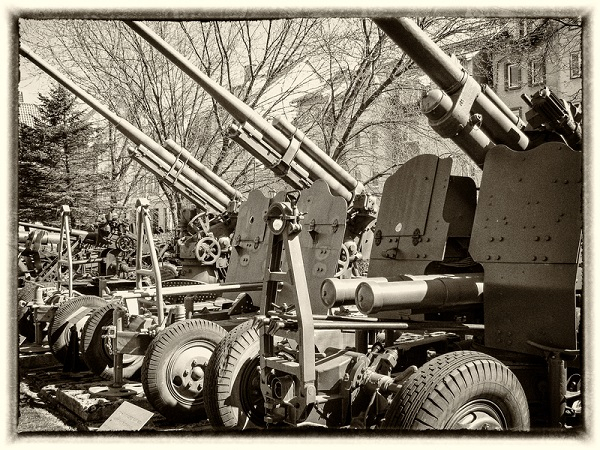

A global battle identified as World War II raged from 1939 until 1945. The large majority of the world's nations engaged in warfare as supporters of the Allies and the Axis, two opposing military organisations. The Second Sino-Japanese War, Spanish Civil War, the Second Sino-Japanese War, the growth of fascism across Europe, and the escalating anxieties in Europe since World War I have all been contributory catalysts to World War II. On September 3, 1939, the United Kingdom and France announced war on Germany.

Old photo of cannon from the time of World War II
World War II was battled by two groups of nations. The Axis was the collective name for Japan, Italy, and Nazi Germany. Many other nations were participants of the Axis or collaborated with it. The nations battling them were known as the Allies. France and Great Britain have been the two main Allies initially, but France capitulated to Germany in 1940. They targeted American and British colonies in the Pacific. America officially proclaimed war against Japan. Then, the U.S. was at war with both Germany and Italy. At this time, Germany was being attacked by the US, UK, and USSR.
The leaders of the Allied army would be American President Franklin D. Roosevelt, British Prime Minister Winston Churchill, and Soviet Premier Josef Stalin.
German tyrant Adolf Hitler, Italian leader Benito Mussolini, and Japanese show emperor Hirohito commanded the Axis camp.
The key goals of the Allies were to bring a stop to the clash and release the territories that were enslaved by the Axis powers.
The Nazi German attack on Poland on September 1, 1939, and the following war declarations on Germany by France and Britain were the immediately triggering events.
The socioeconomic and geopolitical structure of the globe has profoundly and completely altered by the time World War I ended in late 1918. Most European economies and infrastructures were severely damaged.
The two core parts of the French national strategy were reparation payments to Germany in the form of cash and coal. To reimburse for its shortage of resources, the French administration leased capital from the United States and issued an enormous amount of currency.
In 1933–1934, upon gaining total authority, Hitler, and their Nazis transformed Germany into a monarchy with a strongly unfavourable approach toward the Treaty of Versailles and Jews.
During the “phoney war,' a few indications of hostilities were present, and citizens of the western European nations escaped to safety.
On the occasion that Poland was seized by Germany, France, and Great Britain would offer military aid. Hitler planned to overrun Poland. After secret talks in August 1939, the German-Soviet Non-aggression pact was established in Moscow in 1939. Additionally, in September, Russia invaded Poland after Germany, and then Poland had been divided into two conquerors.
Germany attacked France, Holland, and Belgium once the war with the Scandinavian nations finally ended. Hitler focused on Britain after defeating France and started making plans for an attack.
The US Navy station in Hawaii, Pearl Harbor, was abruptly assaulted on December 7, 1941, by the Japanese, who had grown weary of American trade restrictions. Then Germany launched a war on the US. Also, Japan occupied the Philippines, Hong Kong, and Burma.
Germany lost all control of Kharkiv and Kiev once more. Allied bombers started conducting massive daytime air strikes against German towns. Then Mussolini was arrested and killed by Italian partisans, and Hitler committed suicide on December 30.
one bomb was fired on the Japanese town of Hiroshima on August 6, 1945. Another one was thrown on Nagasaki after three days. Such attempts were unrecoverable, and on August 14 the Japanese gave up. The conclusion of World War II occurred with Japan's capitulation.
Lots of people were killed and homeless after the war. The market of European had been destroyed, and a significant proportion of the manufacturing capacity was also destroyed. The Soviet Union also tolerated it significantly. George Marshall, State Secretary for the United States, developed the “European Recovery Program,” referred to as the Marshall Plan, in 1947. Following this, the United States authority committed US$13 billion towards the restoration of the Western European nations.
After the war, imperialism and colonialism were over. Italy and Germany's dictatorships were ended. East Germany and West Germany became two parts of Germany. The United States, France, and Great Britain governed West Germany. India's desire for self-authority was assisted by the Second World War, as it resulted in the decline of British power and the rise of America and Russia as major global powers.
The World War II battle, which spanned 1939-45, was battled in Europe, northern Africa, and Asia. One of history's most devastating wars in which the Allies, the Soviet Union, the United Kingdom, and the United States contested against the Axis Powers—Italy, Germany, and Japan. At last, not only warriors but also common people would have died in huge numbers. There were deliberate, industrial butchers during World War II. After the German attack on Poland in 1939, the UK formally proclaimed war on Germany. The aggressive strike caused the US and the Soviet Union to enter into a major fight. It would be a war in Europe for more than six years.
Q1. What influenced the Second World War?
Ans. World War II had quite several significant roots. Among them are the repercussions of the 1919 Treaty of Versailles, the Financial Depression, the disintegration of diplomacy, the emergence of militaristic activity in Germany and Japan, and the dissolution of the League of Nations.
Q2. How did the Second World War impact regular life?
Ans. Many people were pushed to leave their homes or surrender their property by collecting no payment to shift to new locations. Even in rich Western Europe, times of famine grew increasingly regular.
Q3. Which nation lost the most people during World War 2?
Ans. The Soviet Union experienced the largest number of deaths of any country, with figures often varying from 22 to 27 million.